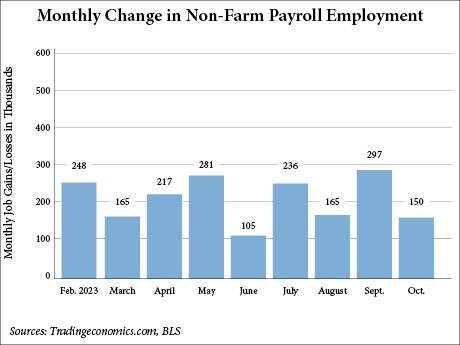WASHINGTON, D.C. — Total nonfarm employment in the United States rose by 150,000 jobs in October, according to the U.S. Bureau of Labor Statistics (BLS). This figure both marks a notable decline from September, which saw the addition of 297,000 jobs, and falls short of expectations for October. Previously, Dow Jones economists predicted a rise of 170,000 for the month, reports CNBC. October’s employment gain is also below the average monthly gain of 258,000 over the previous 12 months.
While the sectors of healthcare, government and social assistance saw job gains, manufacturing jobs decreased, which the BLS report attributes to strike activity. Manufacturing employment decreased by 35,000 positions, including a decline of 33,000 in motor vehicles and parts manufacturing.
Healthcare, government and social assistance added 58,000, 51,000 and 19,000 jobs, respectively. Construction employment also increased, with the addition of 23,000 jobs. Leisure and hospitality and professional business services saw more modest gains, adding 19,000 and 15,000 jobs, respectively. Other industries saw minimal changes.
The unemployment rate ticked up from 3.8 percent in September to 3.9 percent in October, and is the highest unemployment rate since January 2022.
Some experts predict that the cooler job market reflected in the report portends interest rate cuts by the Federal Reserve next year. (The central bank decided to pause interest rate hikes at its meeting earlier this week.)
“The job market has slowed measurably,” says Lawrence Yun, chief economist of the National Association of Realtors (NAR). “Wage gains also slowed to 4.1 percent, compared to nearly 6 percent last year, which will lower inflationary pressures. The bond market is reacting as if the Fed will be cutting rates in 2024.”
The key benchmark 10-year Treasury yield slid down to 4.55 percent and is below a recent high of 5 percent, Yun points out. “That means mortgage rates will be coming down. The 30-year fixed rate will stick in the 7 percent range for this year but looks to move down into the 6 percent range by the spring of next year.”
Additionally, the jobs report featured revised data for the months of August and September, which were originally reported as seeing gains of 227,000 and 336,000, respectively. August was revised down by 62,000, and September was revised down by 39,000 for a total change of 101,000 fewer jobs than originally reported.


